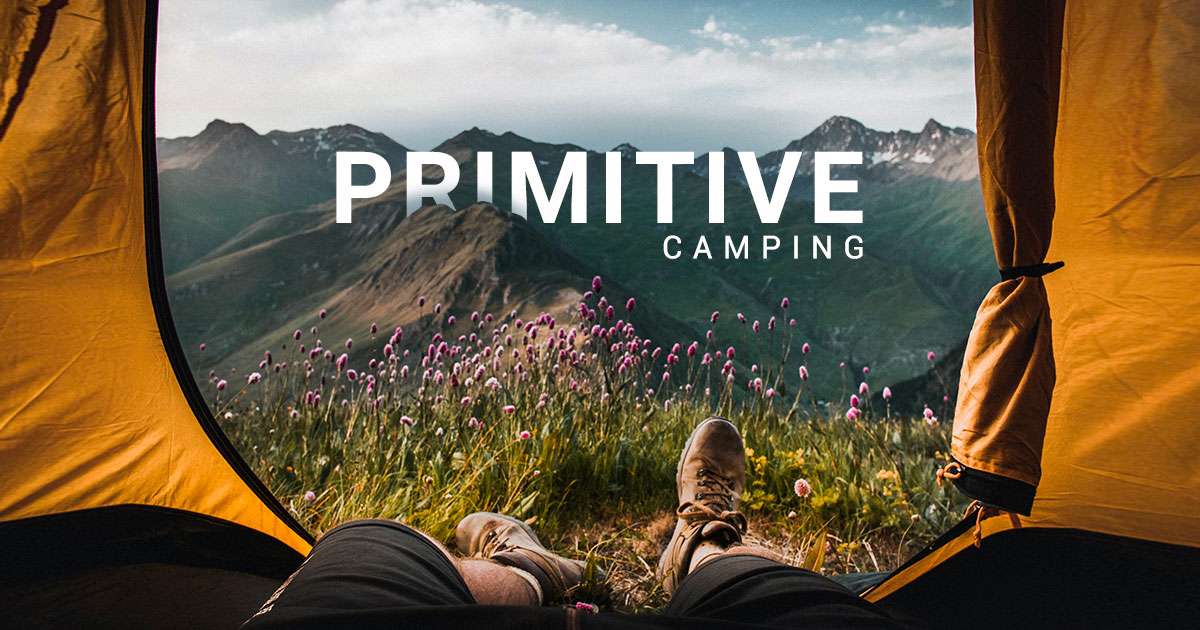What is Primitive Camping: Embracing Nature’s Raw Beauty and Simplicity

Primitive camping is one of the most real and honest ways to enjoy the outdoors. It brings people closer to nature in its simplest form. So, what is primitive camping, and how does one embark on this back-to-basics journey? Let’s delve into the meaning, essentials, and sheer joy of primitive tent camping.
What is Primitive Camping?
Primitive camping is a raw and authentic outdoor experience where individuals immerse themselves in nature without the amenities commonly found in established campgrounds. Unlike traditional camping, primitive camping lacks modern comforts like electricity, running water, or designated camping spots.
It involves embracing simplicity and self-sufficiency, often using minimalistic gear such as primitive tents. To do the least amount of damage to the environment, when you set up a basic camp, you should carefully think about the Leave No Trace principles. The true meaning of primitive camping lies in reconnecting with nature, fostering self-reliance, and appreciating the beauty of untouched landscapes.
Advantages & Disadvantages of Primitive Camping
Here are the pros and cons of primitive tent camping:
Advantages of Primitive Camping
- Authentic Nature Experience: Primitive camping provides a genuine connection to nature, allowing campers to experience the outdoors in its purest form without the distractions of modern life.
- Self-Reliance and Skills Development: Engaging in primitive camping encourages self-sufficiency. Campers develop essential survival skills, such as setting up primitive tents, cooking over an open fire, and navigating without reliance on technology.
- Minimal Environmental Impact: Leave No Trace principles are an important part of primitive camping because they encourage leaving as little of an effect on the environment as possible. Kids at camp learn to value and protect natural areas.
- Cost-Effective: Primitive camping often requires less gear and equipment compared to traditional camping. This makes it a cheaper choice for people who like being outside.
- Escape from Modern Stressors: The simplicity of primitive camping allows individuals to disconnect from the hustle and bustle of daily life, offering a therapeutic escape and promoting mental well-being.
Disadvantages of Primitive Camping
- Lack of Comforts: Primitive camping involves forgoing modern comforts like electricity, running water, and comfortable sleeping arrangements. This can be hard for people who are used to having things easily accessible.
- Weather-Dependent: Primitive camping exposes campers to the elements. Harsh weather conditions can significantly impact the experience, making it less enjoyable during extreme heat, cold, or storms.
- Limited Amenities: Without established campgrounds, primitive camping lacks amenities such as restrooms and designated cooking areas. Campers must be prepared to address basic needs with minimal facilities.
- Safety Concerns: The absence of safety features in remote areas can pose risks. Campers need to be vigilant about wildlife encounters, navigation challenges, and emergency situations without immediate access to assistance.
- Skill Requirement: You need to know how to use the outdoors well in order to go rustic camping. It might be hard for beginners to get used to the lack of amenities and dependence on basic gear.
While primitive camping offers a unique and authentic outdoor experience, individuals must weigh the advantages and disadvantages to ensure it aligns with their preferences, skills, and comfort levels.
What You Need for Primitive Camp
Preparing for primitive camping involves careful consideration of essential gear and supplies to ensure a safe and enjoyable outdoor experience. Here’s a basic list of what you need for your primitive camp:
- Primitive Tent: Choose a durable and weather-resistant tent designed for minimalistic camping. Make sure it’s simple to set up and adequately protects against the weather.
- Sleeping Bag: Buy a good sleeping bag that is right for the weather that you expect. For easy travel, look for something small and light.
- Camping Backpack: Opt for a spacious and comfortable backpack to carry your gear. Ensure it’s designed for the rigors of outdoor use and has adjustable straps for a customized fit.
- Navigation Tools: To find your way in the woods, bring a map, compass, or GPS gadget. Learn about the area and make a plan for your route before you leave on your trip.
- Cooking Equipment: Bring a small stove, cooking tools, and other things you’ll need to make food. Think about choices that are light to reduce the load. If it’s safe and allowed, cooking over an open fire is another basic choice.
- Water Filtration System: Bring a water filtration device or purification tablets to make sure the water is safe. Having reliable access to clean water is important for your health.
- Food Supplies: Bring food that won’t go bad and is easy to make. Think about choices that are light and high in energy to keep you going on the trip.
- Clothing: Pack clothes that are right for the weather, taking into account that temperatures can change. Bring rain gear, a hat, and clothes that you can add or take off depending on the weather.
- First Aid Kit: Carry a complete first aid kit with all the things you need to treat minor illnesses and accidents. Include any medicines you might need for yourself.
- Multi-Tool or Knife: A tool or knife that can be used for many things is very useful, from making food to dealing with emergencies. Pick something that will last and is small.
- Illumination: Pack a reliable flashlight or headlamp with extra batteries. Adequate illumination is essential, especially during nighttime activities.
- Fire-Starting Tools: Bring waterproof matches, a lighter, or a fire starter to create a campfire for cooking and warmth. Ensure you comply with fire regulations in the area.
- Personal Hygiene Items: Basic items like a small towel, biodegradable soap, a toothbrush, and toothpaste should be brought along. Follow the Leave No Trace principles by having as little of an effect on the world as possible.
- Insect Repellent: Guard against insects by bringing effective insect repellent to ensure a more comfortable camping experience.
- Trash Bags: Carry durable trash bags to pack out all your waste, adhering to Leave No Trace principles and keeping the environment clean.
Remember to check and adhere to local regulations, weather conditions, and specific requirements of the wilderness area you plan to explore. Tailor your gear to the unique challenges of the environment and your personal preferences for a successful primitive camping trip.
Places You Can Do Primitive Camping
Primitive camping opportunities abound in various natural settings, providing enthusiasts with the chance to connect with nature in its rawest form. Here are some places where you can enjoy primitive tent camping:
- National Forests: There are designated primitive camping places in a lot of national forests. Campers can really connect with their natural surroundings in these places, which are often more private and secluded.
- Bureau of Land Management (BLM) Lands: BLM lands often have vast stretches of wilderness where primitive camping is permitted. These areas can include deserts, mountains, and other diverse landscapes.
- State Parks: There are backcountry or primitive camping places in some state parks. Most of the time, these sites are farther away and might not have all the services that developed campgrounds do.
- Wilderness Areas: Designated wilderness areas, managed by various agencies, are often prime locations for primitive camping. These areas prioritize preserving the natural environment and may have specific regulations for low-impact camping.
- National Wildlife Refuges: Some wildlife refuges allow primitive camping, providing opportunities to experience nature and observe local wildlife. Check with the specific refuge for regulations and permitted activities.
- Long-Distance Hiking Trails: Trails like the Appalachian Trail, Pacific Crest Trail, and others offer primitive camping opportunities along their routes. Hikers can find backcountry campsites for a more immersive experience.
- Dispersed Camping on Public Lands: The U.S. Forest Service manages a lot of public spaces where it is legal to camp in a dispersed manner. Campers can set up in undeveloped places that aren’t near other campgrounds.
- Desert Regions: Deserts often have vast expanses of public land where primitive camping is permitted. Be sure to carry sufficient water and follow Leave No Trace principles in these fragile ecosystems.
- Beaches and Coastal Areas: Some coastal areas permit primitive camping, offering the unique experience of camping by the sea. Check local regulations and tides before setting up camp.
- Remote Lakes and Rivers: In some areas, you can enjoy primitive camping along remote lakeshores or riversides. This provides the opportunity for water-based activities in addition to camping.
- Backcountry Campsites in National Parks: While many national parks have developed campgrounds, some also offer backcountry campsites for those seeking a more primitive experience. Permits may be required.
- Private Land with Permission: In some cases, private landowners may allow primitive camping on their property. Always seek permission and respect any guidelines they provide.
Before embarking on a primitive camping trip, research and plan accordingly. To have the least amount of effect on the environment, check with the managing agencies for specific rules, get any permits you may need, and follow the “Leave No Trace” principles.
Assemble Your Primitive Camp Now!
Embarking on a primitive camping adventure opens the door to an authentic connection with nature in its purest form. Whether nestled in the tranquility of a national forest, exploring the vastness of BLM lands, or traversing long-distance trails, these pristine settings offer a canvas for unforgettable experiences.
From the rugged terrain of deserts to the serene shores of coastal areas, primitive camping allows enthusiasts to embrace self-sufficiency and immerse themselves in the raw beauty of the outdoors. As you set out on your journey, remember to tread lightly, respect the environment, and savor the simplicity that comes with camping off the beaten path. Not just the end goal, but also the trip back to nature’s roots, which is very rewarding.

